Drought Stress and Livelihood Response Based on Evidence from the Koshi River Basin in Nepal: Modeling and Applications
Abstract
1. Introduction
2. Methodology
2.1. Study Area
2.1.1. Topography
2.1.2. Climate
2.1.3. Social Economy
2.1.4. Culture Norms
2.2. Data Collection
2.3. The Empirical Estimation Technique
2.4. Approaches to Measuring Vulnerability
3. Results
3.1. Exposure and Sensitivity
3.2. Adaptive Capacity
3.3. The Estimation of Overall Drought Vulnerability
3.4. The Impact of Drought Vulnerability on Livelihood Strategies
3.5. Adaptation Strategies for Drought Disasters
4. Discussion
5. Conclusions
Author Contributions
Funding
Conflicts of Interest
References
- Li, L.; Cao, R.; Wei, K.; Wang, W.; Chen, L. Adapting climate change challenge: A new vulnerability assessment framework from the global perspective. J. Clean. Prod. 2019, 217, 216–224. [Google Scholar] [CrossRef]
- de Silva, M.; Kawasaki, A. Socioeconomic Vulnerability to Disaster Risk: A Case Study of Flood and Drought Impact in a Rural Sri Lankan Community. Ecol. Econ. 2018, 152, 131–140. [Google Scholar] [CrossRef]
- Dinar, A.; Mendelsohn, R.; Evenson, R.; Parikh, J.; Sanghi, A.; Kumar, K.; McKinsey, J.; Lonergan, S. Measuring the Impact of Climate Change on Indian Agriculture. Bangladesh 1998, 40, 383. [Google Scholar] [CrossRef]
- Nicholls, R.J.; Hoozemans, F.; Marchand, M. Increasing flood risk and wetland losses due to global sea-level rise: Regional and global analyses. Glob. Environ. Chang. 1999, 9, 69–87. [Google Scholar] [CrossRef]
- Castree, N. The Politics of Climate Change—By Anthony Giddens. Soc. Rev. 2010, 58, 156–162. [Google Scholar] [CrossRef]
- Samir, K.C. Community Vulnerability to Floods and Landslides in Nepal. Ecol. Soc. 2013, 18, 8. [Google Scholar] [CrossRef]
- Eriyagama, N.; Smakhtin, V.; Gamage, N. Mapping Drought Patterns and Impacts: A Global Perspective; IWMI Research Report; International Water Management Institute: Colombo, Sri Lanka, 2009. [Google Scholar]
- Lybbert, T.J.; Carter, M.R. Chapter 22—Bundling Drought Tolerance and Index Insurance to Reduce Rural Household Vulnerability to Drought; Sustainable Economic Development; Elsevier Inc.: Amsterdam, The Netherlands, 2015; pp. 401–414. [Google Scholar]
- Boano, D.C.; Zetter, R.; Morris, D.T. Environmentally displaced people: Understanding the linkages between environmental change, livelihoods and forced migration. Refug. Stud. Cent. 2008, 19, 60–64. [Google Scholar]
- Mohmmed, A.; Li, J.; Elaru, J.; Elbashier, M.M.; Keesstra, S.; Artemi, C.; Martin, K.; Reuben, M.; Teffera, Z.L. Assessing drought vulnerability and adaptation among farmers in Gadaref region, Eastern Sudan. Land Use Policy 2018, 70, 402–413. [Google Scholar] [CrossRef]
- Gain, A.K.; Giupponi, C.; Renaud, F.G. Climate Change Adaptation and Vulnerability Assessment of Water Resources Systems in Developing Countries: A Generalized Framework and a Feasibility Study in Bangladesh. Water 2012, 4, 345–366. [Google Scholar] [CrossRef]
- Smit, B.; Wandel, J. Adaptation, adaptive capacity, and vulnerability. Glob. Environ. Chang. 2006, 16, 282–292. [Google Scholar] [CrossRef]
- Jackson, S.T.; Betancourt, J.L.; Booth, R.K.; Gray, S.T. Ecology, and the ratchet of events: Climate variability, niche dimensions, and species distributions. Proc. Natl. Acad. Sci. USA 2009, 106, 19685–19692. [Google Scholar] [CrossRef] [PubMed]
- Pandey, R.; Jha, S.K.; Alatalo, J.M.; Archie, K.M.; Gupta, A.K. Sustainable livelihood framework-based indicators for assessing climate change vulnerability and adaptation for Himalayan communities. Ecol. Indic. 2017, 79, 338–346. [Google Scholar] [CrossRef]
- Reed, M.S.; Podestá, G.; Fazey, I.; Geeson, N.; Hessel, R.; Hubacek, K.; Letson, D.; Nainggolan, D.; Prell, C.; Rickenbach, M.; et al. Combining analytical frameworks to assess livelihood vulnerability to climate change and analyse adaptation options. Ecol. Econ. 2013, 94, 66–77. [Google Scholar] [CrossRef]
- Paavola, J. Livelihoods, vulnerability, and adaptation to climate change in Morogoro, Tanzania. Environ. Sci. Policy 2008, 11, 642–654. [Google Scholar] [CrossRef]
- Wang, B.; Feng, P.; Liu, D.L.; Waters, C. Modelling biophysical vulnerability of wheat to future climate change: A case study in the eastern Australian wheat belt. Ecol. Indic. 2020, 114. [Google Scholar] [CrossRef]
- Hursh, A.; Ballantyne, A.; Cooper, L.; Maneta, M.; Kimball, J.; Watts, J. The sensitivity of soil respiration to soil temperature, moisture, and carbon supply at the global scale. Glob. Chang. Boil. 2016, 23, 2090–2103. [Google Scholar] [CrossRef]
- Kim, B.-T.; Brown, C.L.; Kim, D.-H. Assessment on the vulnerability of Korean aquaculture to climate change. Mar. Policy 2019, 99, 111–122. [Google Scholar] [CrossRef]
- Scott, D.; Hall, C.M.; Gössling, S. Global tourism vulnerability to climate change. Ann. Tour. Res. 2019, 77, 49–61. [Google Scholar] [CrossRef]
- Dewan, T.H. Societal impacts, and vulnerability to floods in Bangladesh and Nepal. Weather Clim. Extrem. 2015, 7, 36–42. [Google Scholar] [CrossRef]
- Nagoda, S.; Nightingale, A.J. Participation and Power in Climate Change Adaptation Policies: Vulnerability in Food Security Programs in Nepal. World Dev. 2017, 100, 85–93. [Google Scholar] [CrossRef]
- Baffoe, G.; Matsuda, H. An Empirical Assessment of Households Livelihood Vulnerability: The Case of Rural Ghana. Soc. Indic. Res. 2017, 140, 1225–1257. [Google Scholar] [CrossRef]
- Sullivan, C.; Meigh, J. Targeting attention on local vulnerabilities using an integrated index approach: The example of the climate vulnerability index. Water Sci. Technol. 2005, 51, 69–78. [Google Scholar] [CrossRef]
- Mainali, J.; Pricope, N.G. High-resolution spatial assessment of population vulnerability to climate change in Nepal. Appl. Geogr. 2017, 82, 66–82. [Google Scholar] [CrossRef]
- Project HVI. Available online: http://dialogue2011.fanrpan.org/sites/default/files/publications/Project-HVI_September2011.pdf (accessed on 9 May 2020).
- Pham, N.T.T.; Nong, D.; Sathyan, A.R.; Garschagen, M. Vulnerability assessment of households to flash floods and landslides in the poor upland regions of Vietnam. Clim. Risk Manag. 2020, 28, 100215. [Google Scholar] [CrossRef]
- Martin, R.; Linstädter, A.; Frank, K.; Müller, B. Livelihood security in face of droughtpAssessing the vulnerability of pastoral households. Environ. Model. Softw. 2016, 75, 414–423. [Google Scholar] [CrossRef]
- Aryal, K. Disaster vulnerability in Nepal. Int. J. Disaster Risk Reduct. 2014, 9, 137–146. [Google Scholar] [CrossRef]
- Sellmyer, A.; Vasily, L.; Thomas, S. Annual Report 2018; International Centre for Integrated Mountain Development (ICIMOD): Kathmandu, Nepal, 2018. [Google Scholar]
- United Nations Development Programme (UNDP). Reducing Disaster Risk—A Challenge for Development; United Nations Development Programme: New York, NY, USA, 2004. [Google Scholar]
- Yohe, G.; Tol, R.S. Indicators for social and economic coping capacity—Moving toward a working definition of adaptive capacity. Glob. Environ. Chang. 2002, 12, 25–40. [Google Scholar] [CrossRef]
- Shewmake, S. Vulnerability and the Impact of Climate Change in South Africa’s Limpopo River Basin; International Food Policy Research Institute Discussion: Washington, DC, USA, 2008. [Google Scholar]
- Khadka, C.; Aryal, K.P.; Edwards-Jonášová, M.; Upadhyaya, A.; Dhungana, N.; Cudlin, P.; Vacik, H. Evaluating participatory techniques for adaptation to climate change: Nepal case study. For. Policy Econ. 2018, 97, 73–82. [Google Scholar] [CrossRef]
- Nie, Y. Land cover changes in Mt. Qomolangma region. Ph.D. Thesis, University of Chinese Academy of Sciences, Beijing, China, 2010. [Google Scholar]
- Gupta, A.K.; Negi, M.; Nandy, S.; Alatalo, J.M.; Singh, V.; Pandey, R. Assessing the vulnerability of socio-environmental systems to climate change along an altitude gradient in the Indian Himalayas. Ecol. Indic. 2019, 106, 105512. [Google Scholar] [CrossRef]
- Yatagai, A.; Kamiguchi, K.; Arakawa, O.; Hamada, A.; Yasutomi, N.; Kitoh, A. Aphrodite: Constructing a Long-Term Daily Gridded Precipitation Dataset for Asia Based on a Dense Network of Rain Gauges. Bull. Am. Meteorol. Soc. 2012, 93, 1401–1415. [Google Scholar] [CrossRef]
- Winter Drought Worsens Food Insecurity in Nepal. Available online: https://www.wfp.org/news/news-release/winter-drought-worsens-food-insecurity-nepal (accessed on 14 January 2020).
- International Centre for Integrated Mountain Development (ICIMOD). Available online: https://www.icimod.org/ (accessed on 21 February 2020).
- Statistical Yearbook Nepal; Nepal Central Bureau of Statistics: Kathmandu, Nepal, 2016; ISBN 9789937-0-1707-7.
- Religions in Nepal. Available online: https://www.imnepal.com/major-religions-in-nepal-hindu-buddhism-muslim/ (accessed on 21 February 2020).
- EMP. Available online: https://guides.libraries.psu.edu/emp (accessed on 21 April 2020).
- QuestionPro. Available online: https://www.questionpro.com/blog/empirical-research/ (accessed on 21 April 2020).
- Hahn, M.B.; Riederer, A.M.; Foster, S.O. The Livelihood Vulnerability Index: A pragmatic approach to assessing risks from climate variability and change—A case study in Mozambique. Glob. Environ. Chang. 2009, 19, 74–88. [Google Scholar] [CrossRef]
- World Health Organization (WHO). Immunization Coverage Cluster Survey—Reference Manual; WHO Document Production Services: Geneva, Switzerland, 2005. [Google Scholar]
- Gbetibouo, G.A.; Ringler, C. Mapping South African Farming Sector Vulnerability to Climate Change and Variability: A Subnational Assessment; The International Food Policy Research Institute: Amsterdam, Netherlands, 2009; pp. 175–187. [Google Scholar]
- Wang, L.; Xiong, W.; Wen, X.; Feng, L. Effect of climatic factors such as temperature, precipitation on maize production in china. Trans. Chin. Soc. Agric. Eng. 2014, 30, 138–146. [Google Scholar]
- Esperon-Rodriguez, M.; Bonifacio-Bautista, M.; Barradas, V.L. Socio-economic vulnerability to climate change in the central mountainous region of eastern Mexico. Ambio 2015, 45, 146–160. [Google Scholar] [CrossRef]
- Perch-Nielsen, S.L. The vulnerability of beach tourism to climate change—An index approach. Clim. Chang. 2009, 100, 579–606. [Google Scholar] [CrossRef]
- Keshavarz, M.; Maleksaeidi, H.; Karami, E. Livelihood vulnerability to drought: A case of rural Iran. Int. J. Disaster Risk Reduct. 2017, 21, 223–230. [Google Scholar] [CrossRef]
- Alam, G.M.; Alam, K.; Mushtaq, S.; Clarke, M.L. Vulnerability to climatic change in riparian char and river-bank households in Bangladesh: Implication for policy, livelihoods, and social development. Ecol. Indic. 2017, 72, 23–32. [Google Scholar] [CrossRef]
- Ncube, A.; Mangwaya, P.T.; Ogundeji, A.A. Assessing vulnerability and coping capacities of rural women to drought: A case study of Zvishavane district, Zimbabwe. Int. J. Disaster Risk Reduct. 2018, 28, 69–79. [Google Scholar] [CrossRef]
- Dendir, Z.; Simane, B. Livelihood vulnerability to climate variability and change in different agroecological zones of Gurage Administrative Zone, Ethiopia. Prog. Disaster Sci. 2019, 3, 100035. [Google Scholar] [CrossRef]
- Huang, X.; Huang, X.; He, Y.; Yang, X. Assessment of livelihood vulnerability of land-lost farmers in urban fringes: A case study of Xi’an, China. Habitat Int. 2017, 59, 1–9. [Google Scholar] [CrossRef]
- Sullivan, C.; Meigh, J.; Fediw, T. Derivation and Testing of the Water Poverty Index Phase 1; Final report May 2002; Centre for Ecology & Hydrology: London, UK, 2002. [Google Scholar]
- He, R.; Yang, Z.; Li, X.; Li, Z.; Liu, Z.; Chen, F. A comprehensive approach for fracability evaluation in naturally fractured sandstone reservoirs based on analytical hierarchy process method. Energy Sci. Eng. 2019, 7, 529–545. [Google Scholar] [CrossRef]
- International Rice Research Institute (IRRI). Vulnerability to Climate Variability and Drought among Small and Marginal Farmers: A Case Study in Odisha, India; Climate and Development; International Rice Research Institute (IRRI): Los Banos, Philippines, 2016. [Google Scholar]
- Jamir, C.; Sharma, N.; Sengupta, A.; Ravindranath, N.H. Farmers’ vulnerability to climate variability in Dimapur district of Nagaland, India. Reg. Environ. Chang. 2012, 13, 153–164. [Google Scholar] [CrossRef]
- Hoque, M.A.-A.; Pradhan, B.; Ahmed, N. Assessing drought vulnerability using geospatial techniques in northwestern part of Bangladesh. Sci. Total. Environ. 2020, 705, 135957. [Google Scholar] [CrossRef]
- Ahmadalipour, A.; Moradkhani, H. Multi-dimensional assessment of drought vulnerability in Africa: 1960–2100. Sci. Total. Environ. 2018, 644, 520–535. [Google Scholar] [CrossRef] [PubMed]
- Christina, G. Broadening understandings of drought—The climate vulnerability of farmworkers and rural communities in California (USA). Environ. Sci. Policy 2018, 89, 283–291. [Google Scholar]
- Li, J.R. Method, and advances of drought monitoring by remote sensing. J. China Hydrol. 2001, 21, 15–17. [Google Scholar]
- Fields, S. Continental Divide: Why Africa’s Climate Change Burden Is Greater. Environ. Heal. Perspect. 2005, 113, 534–537. [Google Scholar] [CrossRef]
- Davies, M.; Guenther, B.; Leavy, J.; Mitchell, T.; Tanner, T. Climate Change Adaptation, Disaster Risk Reduction and Social Protection: Complementary Roles in Agriculture and Rural Growth? IDS Work. Pap. 2009, 1–37. [Google Scholar] [CrossRef]
- Pandey, R.; Bardsley, D.K. Social-ecological vulnerability to climate change in the Nepali Himalaya. Appl. Geogr. 2015, 64, 74–86. [Google Scholar] [CrossRef]
- Hunzai, K.; Gerlitz, J.Y.; Hoermann, B. Understanding mountain poverty in the Hindu Kush-Himalayas: Regional report for Afghanistan, Bangladesh, Bhutan, China, India, Myanmar, Nepal, and Pakistan. Can. J. Dev. Stud. 2011, 33, 250–265. [Google Scholar]
- Gautam, Y.; Andersen, P. Rural livelihood diversification and household well-being: Insights from Humla, Nepal. J. Rural. Stud. 2016, 44, 239–249. [Google Scholar] [CrossRef]
- Woldenhanna, T.; Oskam, A. Income diversification and entry barriers: Evidence from the Tigray region of northern Ethiopia. Food Policy 2001, 26, 351–365. [Google Scholar] [CrossRef]
- Reardon, T.; Taylor, J.E.; Stamoulis, K.; Lanjouw, P.; Balisacan, A. Effects of Nonarm Employment on Rural Income Inequality in Developing Countries: An Investment Perspective. J. Agr. Econ. 2000, 51. [Google Scholar]
- Barrett, C.B.; Reardon, T.; Webb, P. Nonfarm income diversification and household livelihood strategies in rural Africa: Concepts, dynamics, and policy implications. Food Policy 2001, 26, 315–331. [Google Scholar] [CrossRef]
- Canagarajah, S.; Newman, C.; Bhattamishra, R. Non-farm income, gender, and inequality: Evidence from rural Ghana and Uganda. Food Policy 2001, 26, 405–420. [Google Scholar] [CrossRef]
- Behera, B.; Rahut, D.B.; Sethi, N. Analysis of household access to drinking water, sanitation, and waste disposal services in urban areas of Nepal. Util. Policy 2020, 62, 100996. [Google Scholar] [CrossRef]
- Merz, J.; Nakarmi, G.; Shrestha, S.K.; Dahal, B.M.; Dangol, P.M.; Dhakal, M.P.; Dongol, B.S.; Sharma, S.; Shah, P.B.; Weingärtner, R. Water: A Scarce Resource in Rural Watersheds of Nepal’s Middle Mountains. Mt. Res. Dev. 2003, 23, 41–49. [Google Scholar] [CrossRef]
- Paudel, G.P.; Gartaula, H.; Rahut, D.B.; Craufurd, P. Gender differentiated small-scale farm mechanization in Nepal hills: An application of exogenous switching treatment regression. Technol. Soc. 2020, 61, 101250. [Google Scholar] [CrossRef]
- Sustainable Development Goal 5: Gender Equality. Available online: https://sustainabledevelopment.un.org/sdg5 (accessed on 9 May 2020).
- Cook, J.; Freeman, S.; Hill, M. Shifting Course: Climate Adaptation for Water Management Institutions; WWF-US: Gland, Switzerland, 2010. [Google Scholar]
- von Westarp, S.; Chieng, S.; Schreier, H. A comparison between low-cost drip irrigation, conventional drip irrigation, and hand watering in Nepal. Agric. Water Manag. 2004, 64, 143–160. [Google Scholar] [CrossRef]
- Kapri, K.; Shankar, G. Migration, remittance, and agricultural productivity: Evidence from the Nepal Living Standard Survey. World Dev. Perspect. 2020, 100198. [Google Scholar] [CrossRef]
- Mukherjee, M.; Schwabe, K. Irrigated Agricultural Adaptation to Water and Climate Variability: The Economic Value of a Water Portfolio. Am. J. Agric. Econ. 2014, 97, 809–832. [Google Scholar] [CrossRef]
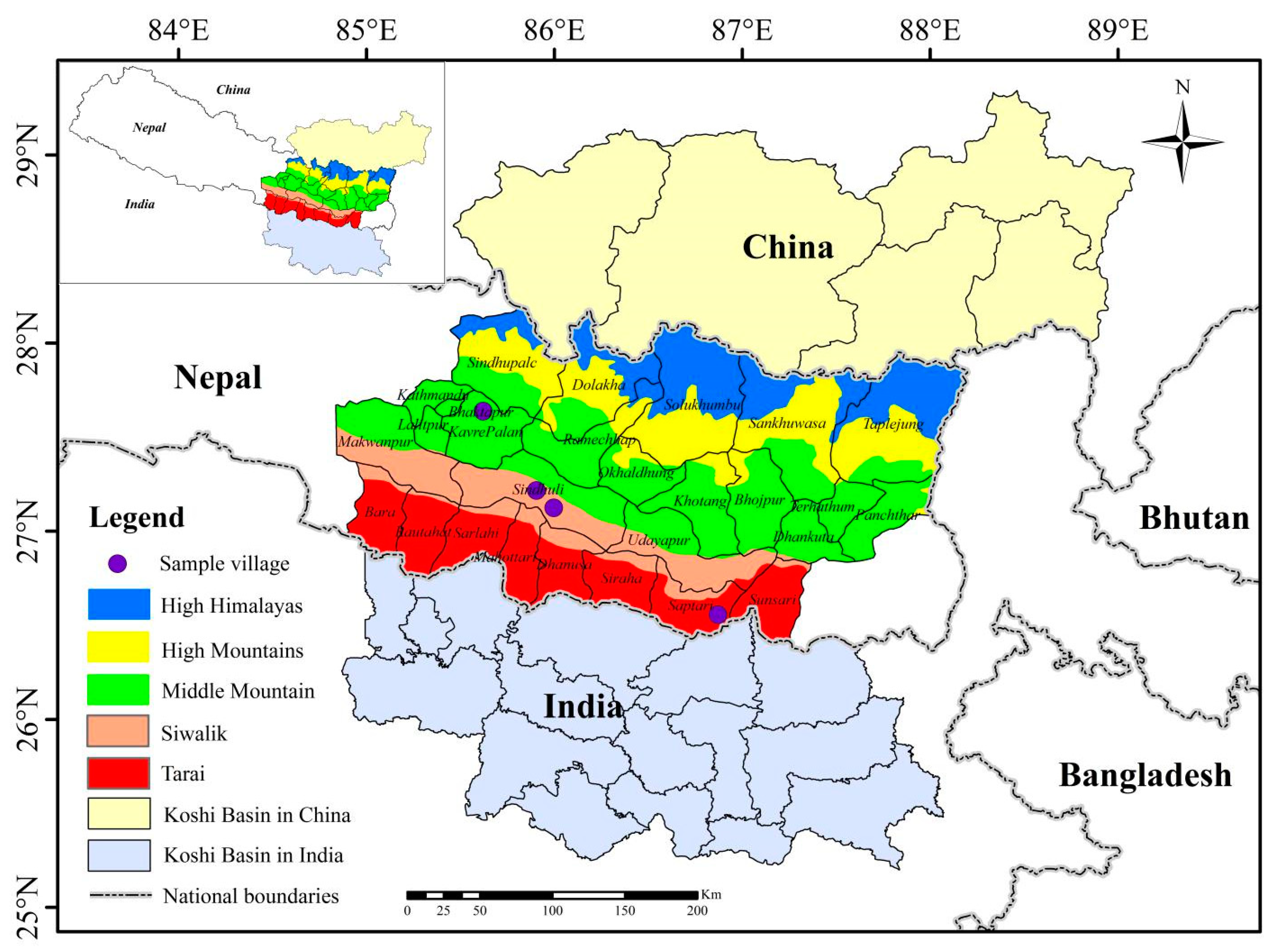
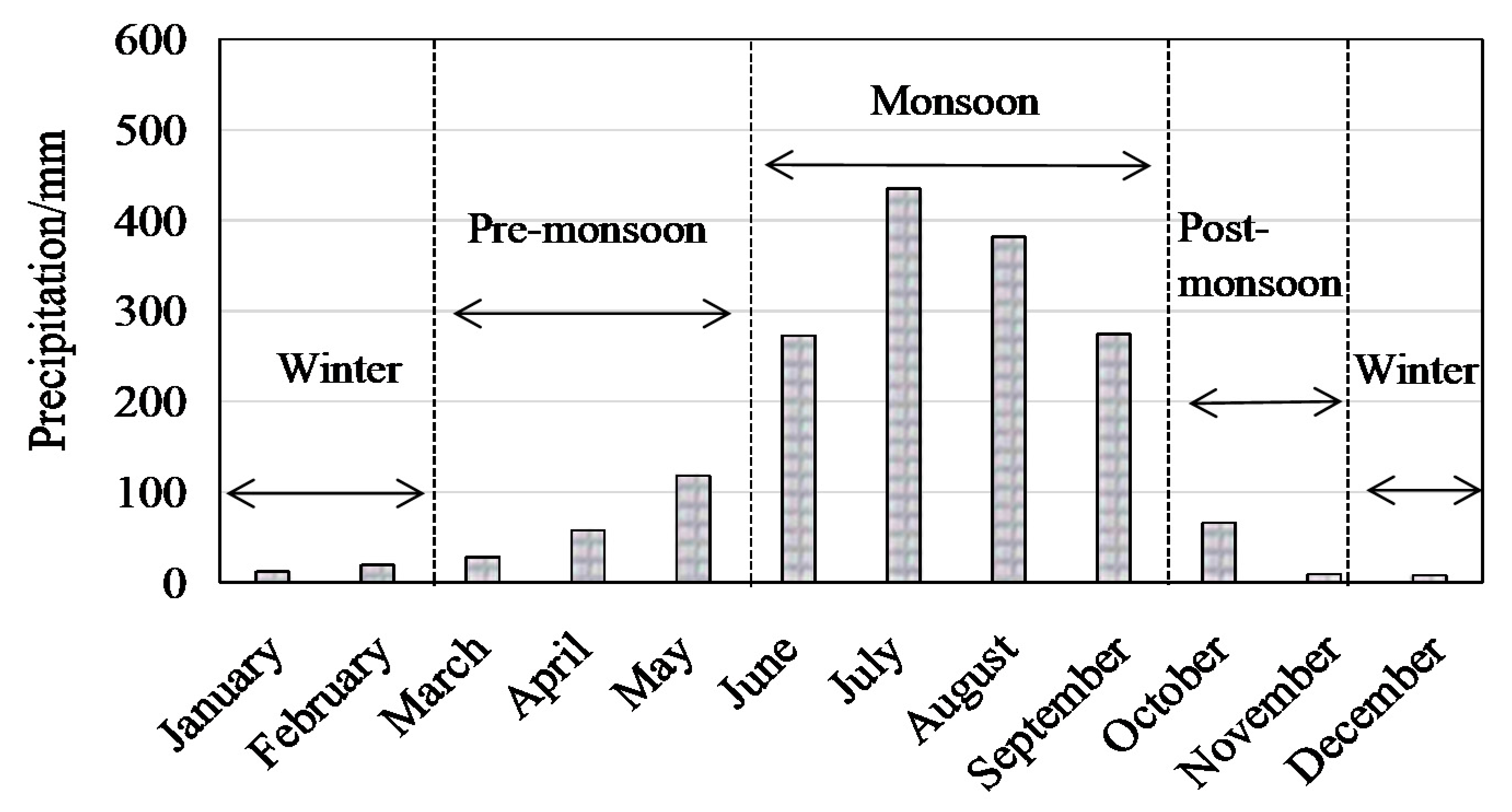
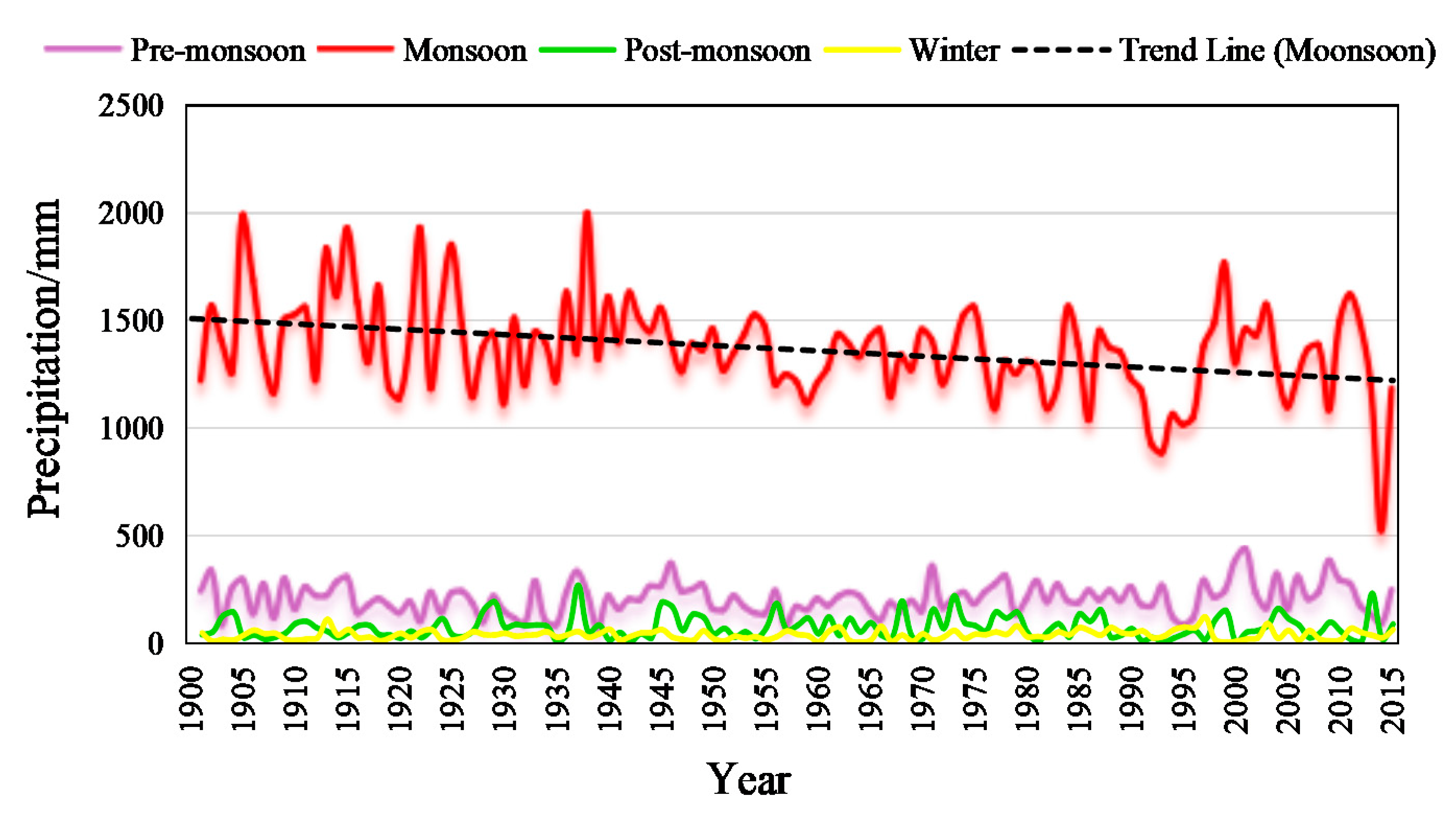
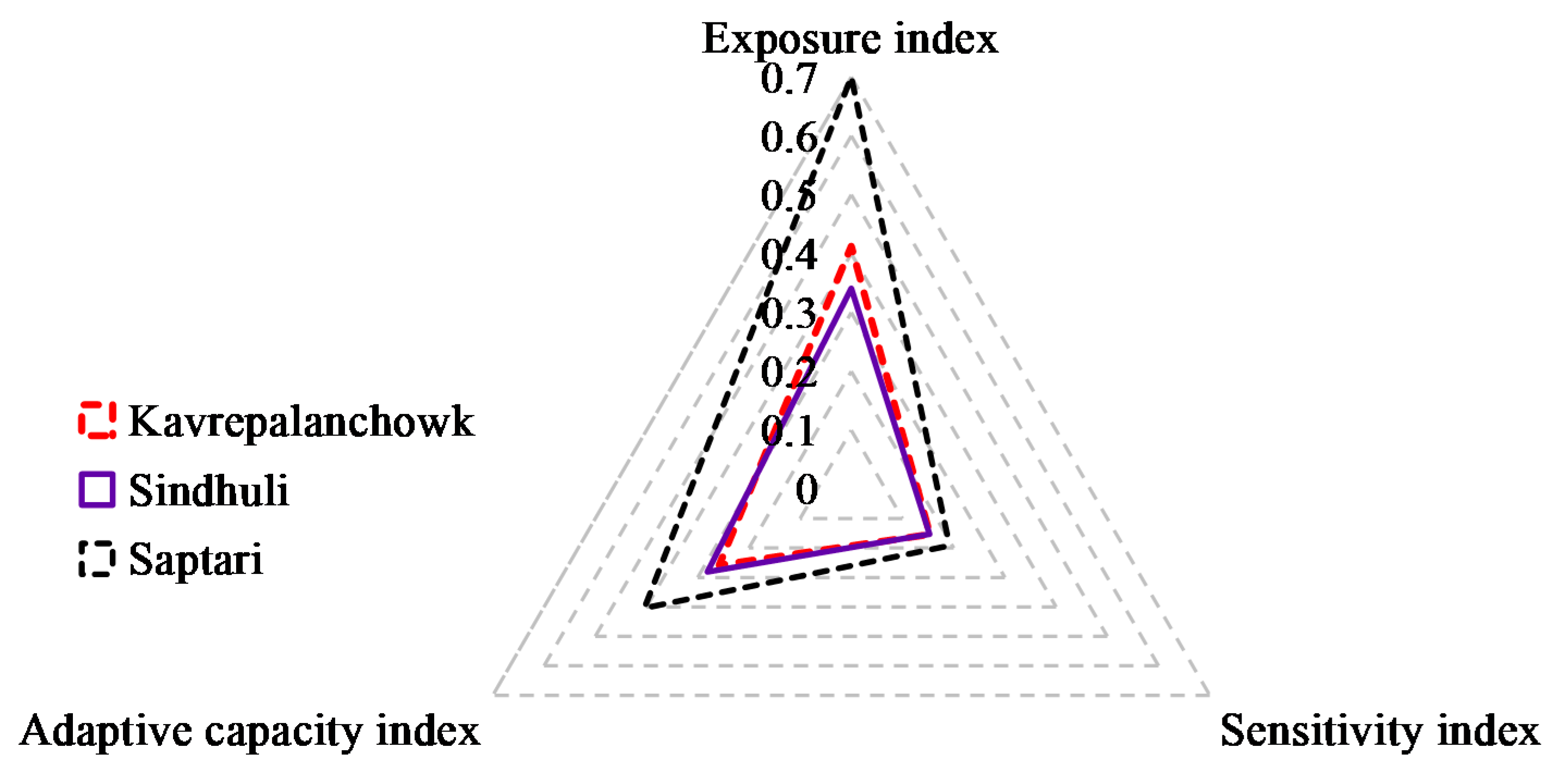
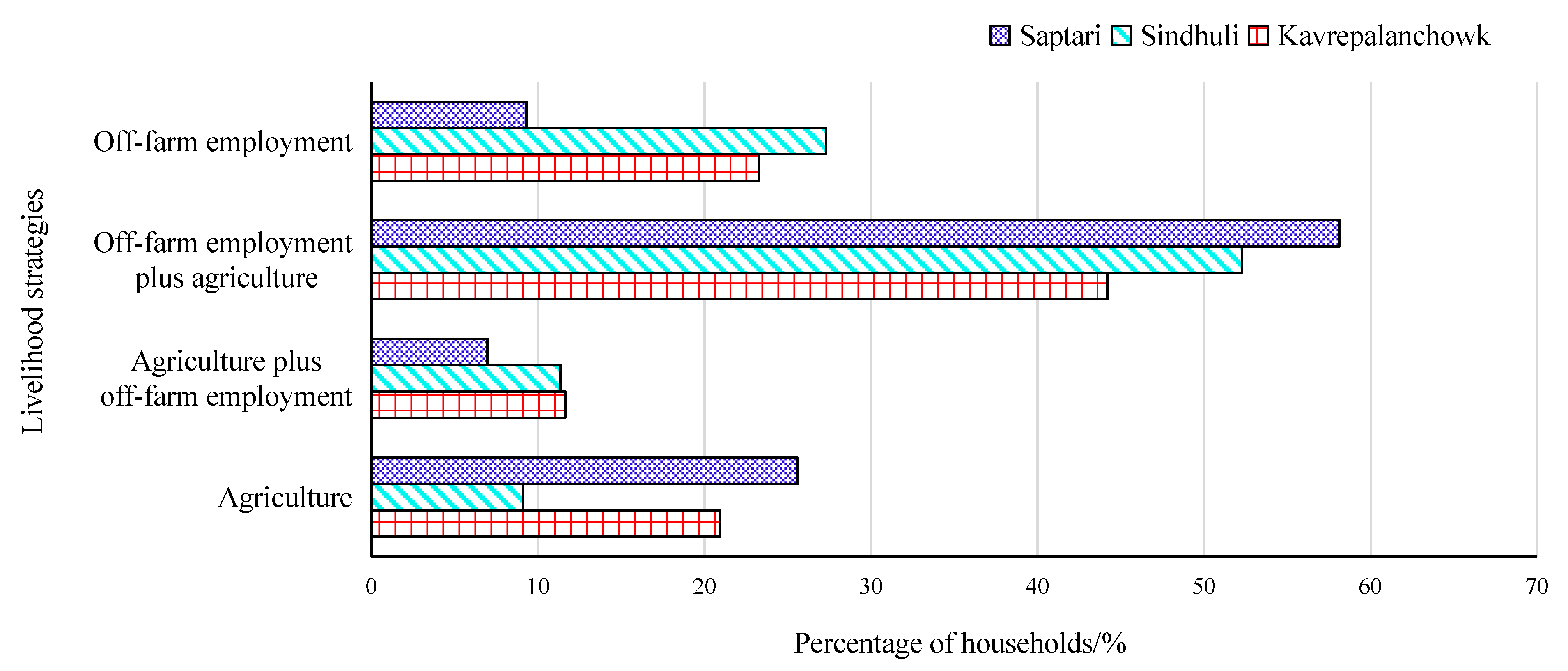
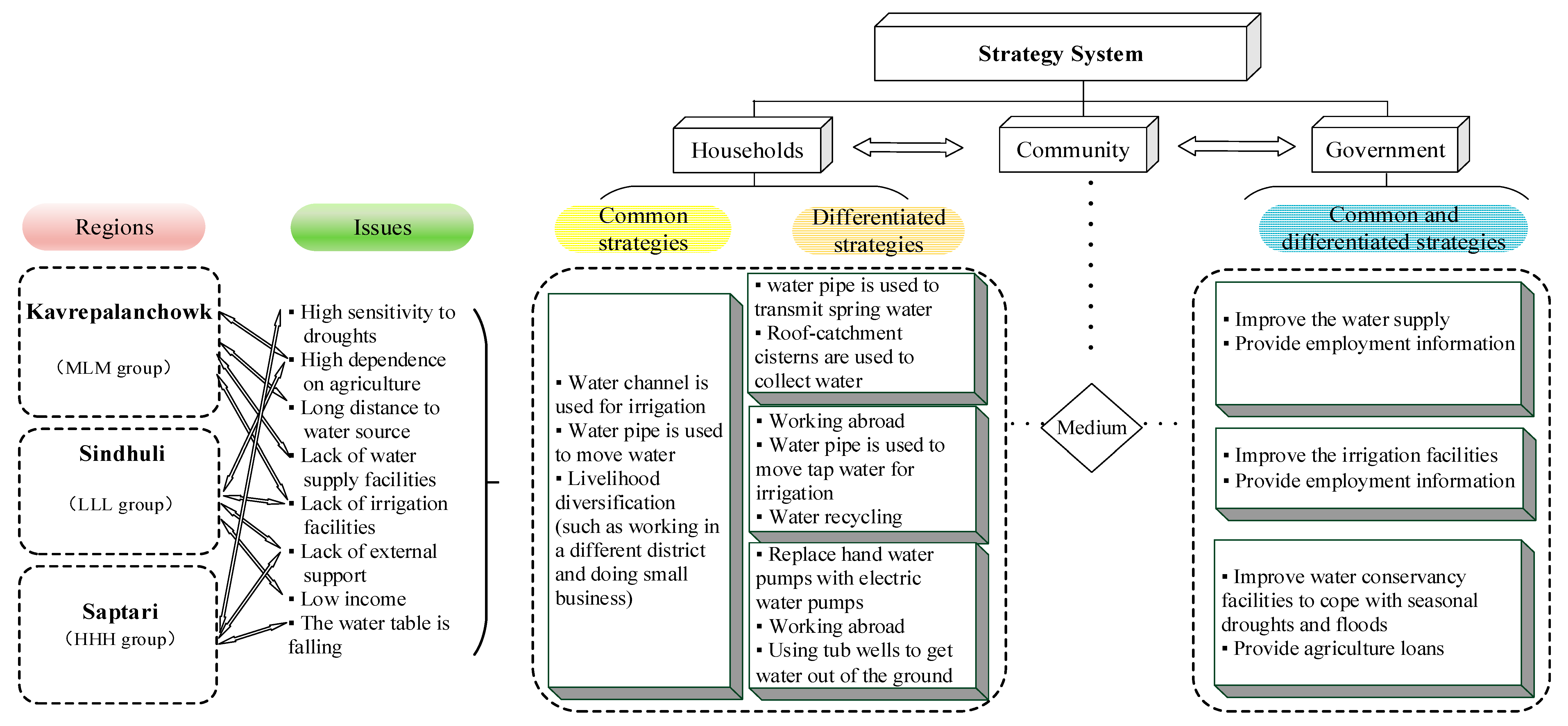
| Agroecological Zones | Sample Districts | Altitude/m | Number of Questionnaires |
|---|---|---|---|
| Middle Mountain | Kavrepalanchowk | 867 | 43 |
| Siwalik | Sindhuli | 414 | 44 |
| Tarai | Saptari | 76 | 43 |
| Major Component | Sub-Component | The Type of Data | Survey Question | Explanation and Measures | The Correlation of the Indicator to the Corresponding Major Component | Source |
|---|---|---|---|---|---|---|
| Exposure | (E1) Drought intensity | Secondary data | − | The crop water stress index was used to describe the drought intensity | + | [49] |
| (E2) Drought duration/months | Secondary data | − | Drought disasters lasted for different periods of time in different regions | + | [50] | |
| (E3) Drought frequency/number | Secondary data | − | Number of occurrences of drought disasters during spring season from 1985 to 2014 | + | [50] | |
| Sensitivity | (S1) Percentage of population who engaged in agriculture/% | Primary data | How many people are there in your family? What’s everyone’s occupation in your family? | − | + | [51] |
| (S2) The area of rainfed agriculture land per household/ha | Primary data | What is the area of rainfed agriculture land in your family? | The more rainfed agriculture land, the more sensitivity to drought disaster | + | [10] | |
| (S3) Number of Livestock per household | Primary data | How many livestock are there in your family? (Including cow, buff, goat, sheep and pig) | − | + | [52] | |
| Adaptive capacity | (A1) Annual household income per capita/USD | Primary data | What is the annual income of each person in your family? | − | + | [10] |
| (A2) Average livelihood diversification index | Primary data | What’s everyone’s occupation in your family? | The livelihood diversity index means how many types of occupations in a family. The larger livelihood index, the stronger capacity adjusts to drought disaster. | + | [2] | |
| (A3) Average time to get water/minutes | Primary data | How long will it take your family to walk to get water? | − | - | [53] | |
| (A4) Percentage of households with irrigation facility/% | Primary data | Where does irrigation water come from? | A. rain B. river C. tap D. borehole E. dam F. well G. others According to the respondents’ answers, we divided the households into the following two groups: households with irrigation facility and households without irrigation facility. Then, we assigned a value of 1 to the former and assigned a value of 0 to the latter. | + | [10] | |
| (A5) Level of external support | Primary data | Did the government give you any help during a drought? Did Non-Governmental Organizations give you any help during a drought? Did any of your relatives help you during a drought | We want to quantify the help of the government, non-governmental organizations, or relative during a drought. If the household received one (two, three) type(s) of external help, we assigned a value of 1(2,3). | + | [51,53,54] |
| Subcomponent | Kavrepalanchowk | Sindhuli | Saptari | Major Component | Kavrepalanchowk | Sindhuli | Saptari |
|---|---|---|---|---|---|---|---|
| E1 | 0.000 | 0.750 | 1.000 | E | 0.413 | 0.341 | 0.700 |
| E2 | 0.380 | 0.000 | 1.000 | ||||
| E3 | 1.000 | 0.140 | 0.000 | ||||
| S1 | 0.333 | 0.356 | 0.354 | S | 0.154 | 0.153 | 0.192 |
| S2 | 0.040 | 0.013 | 0.090 | ||||
| S3 | 0.022 | 0.026 | 0.071 | ||||
| A1 | 0.159 | 0.132 | 0.172 | A | 0.319 | 0.295 | 0.422 |
| A2 | 0.128 | 0.188 | 0.343 | ||||
| A3 | 0.759 | 0.913 | 0.923 | ||||
| A4 | 0.279 | 0.341 | 0.581 | ||||
| A5 | 0.419 | 0.250 | 0.186 | ||||
| Overall DVI | |||||||
| DVI Kavrepalanchowk | 0.014 | ||||||
| DVI Sindhuli | 0.007 | ||||||
| DVI Saptari | 0.053 |
| The Main Sources of Drinking Water | Kavrepalanchowk | Sindhuli | Saptari |
|---|---|---|---|
| Public Taps (%) | 30.23 | 11.36 | 39.53 |
| Private Taps (%) | 18.60 | 40.91 | 4.65 |
| Public Tube Wells (%) | 9.30 | 9.09 | 11.63 |
| Private Tube Wells (%) | 9.30 | 11.36 | 41.86 |
| Spring (%) | 32.56 | 27.27 | 2.33 |
© 2020 by the authors. Licensee MDPI, Basel, Switzerland. This article is an open access article distributed under the terms and conditions of the Creative Commons Attribution (CC BY) license (http://creativecommons.org/licenses/by/4.0/).
Share and Cite
Zhu, R.; Fang, Y.; Neupane, N.; Koirala, S.; Zhang, C. Drought Stress and Livelihood Response Based on Evidence from the Koshi River Basin in Nepal: Modeling and Applications. Water 2020, 12, 1610. https://doi.org/10.3390/w12061610
Zhu R, Fang Y, Neupane N, Koirala S, Zhang C. Drought Stress and Livelihood Response Based on Evidence from the Koshi River Basin in Nepal: Modeling and Applications. Water. 2020; 12(6):1610. https://doi.org/10.3390/w12061610
Chicago/Turabian StyleZhu, Ran, Yiping Fang, Nilhari Neupane, Saroj Koirala, and Chenjia Zhang. 2020. "Drought Stress and Livelihood Response Based on Evidence from the Koshi River Basin in Nepal: Modeling and Applications" Water 12, no. 6: 1610. https://doi.org/10.3390/w12061610
APA StyleZhu, R., Fang, Y., Neupane, N., Koirala, S., & Zhang, C. (2020). Drought Stress and Livelihood Response Based on Evidence from the Koshi River Basin in Nepal: Modeling and Applications. Water, 12(6), 1610. https://doi.org/10.3390/w12061610





